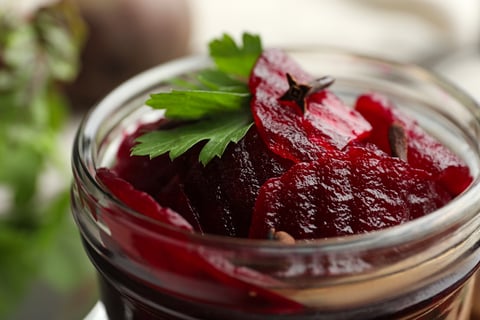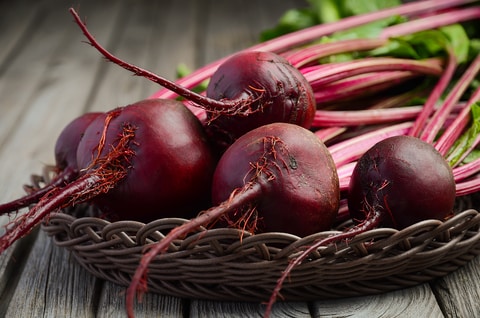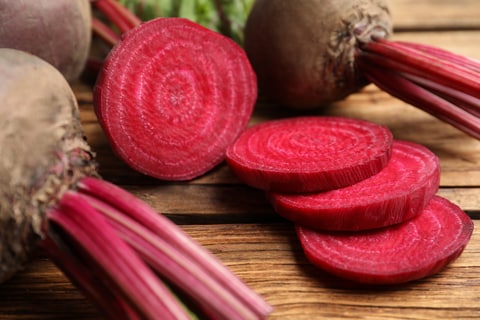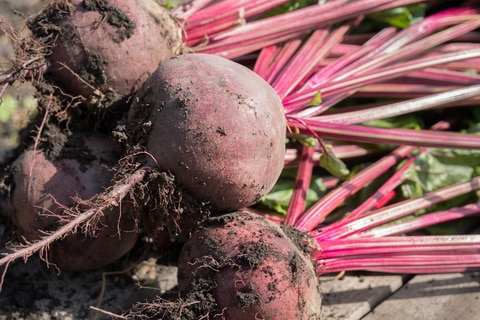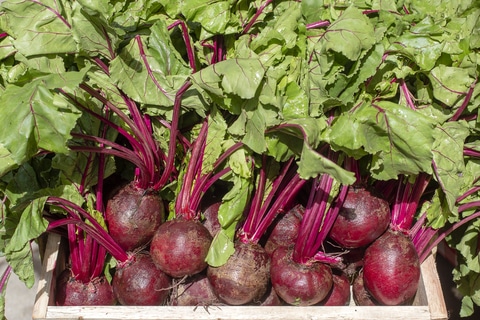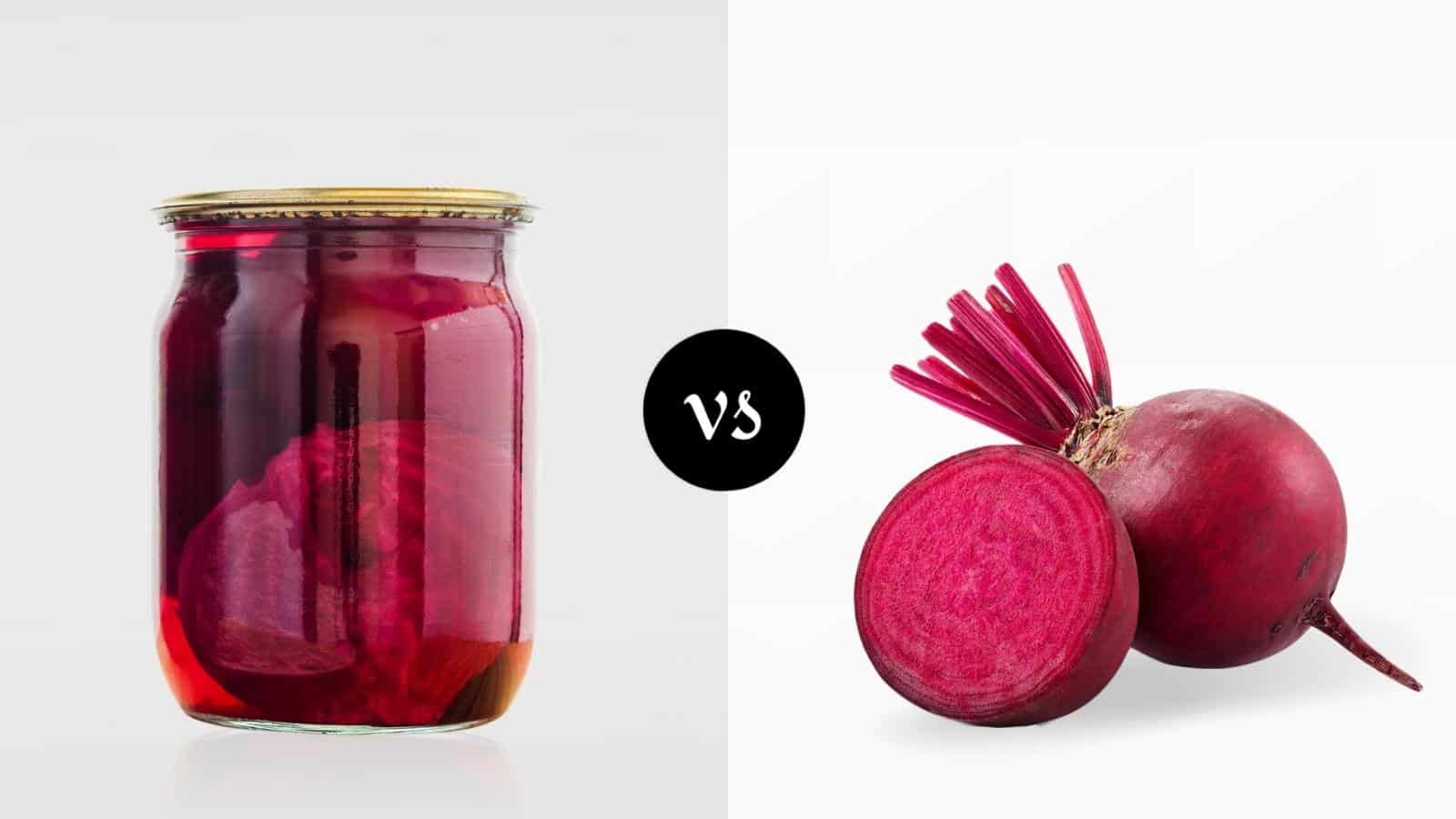
Beetroot is a famous plant that is mostly known as beets in the USA and Canada. In the UK, however, it’s termed ‘beetroot’ – British English. This plant has many different varieties, but most of us know the famous red beet.
These tasty tubers are packed with numerous minerals and vitamins that our body requires, and the bright color strongly indicates the powerful underlying antioxidant activity.
Beets lower blood pressure and promote better blood vessel function while lowering the risk of heart disease.
Yet, with all the benefits and immensely tasty flavor, which is the better choice between canned beets vs. fresh beets?
We’ve got a comprehensive comparison of both coming up, giving you everything that you need to know to never be left confused in the grocery store.
Canned Beets Vs. Fresh Beets Comparison
| Canned Beets | Fresh Beets | |
|---|---|---|
| Varieties | Red/Purple Beets | Sliced, Crinkle Cut, Whole, Grated, Baby Beets | Red/Purple Beets, Golden Beets, Striped Beets, Cylindra Beets, Mangel-Wurzel Beets, Sugar Beets |
| Nutrition | On Par With Fresh, Higher Phosphorus, Folate And Potassium | 35 Calories, 1 G Protein, 8 G Carbohydrates, 1 G Fiber, 6 G Sugar, 0.4 Milligrams Iron, Manganese, Vitamin B2, Betaine |
| Flavor | Identical To Fresh Beets | Almost Identical In Flavor To Canned, Slightly Sweeter With Slightly More Complex Depth Of Flavor And Prevailing Fresh Earthiness |
| Shelf Life | Up To 2 Years When Correctly Stored | 2 Weeks Refrigerated |
| Versatility | All-Purpose Versatility, Cannot Consume Raw For Full Nutritional Value When Canned | Raw Or Cooked, All-Purpose Versatility |
| Availability | All Year Around Availability | All Year Around Availability | Best Harvest June, September, October In US |
| Affordability | $1-3/15-Ounce Can | $2.50-$3/Pound |
| Considerations | Avoid Artificial Sweeteners & Preservatives, Look For BPA-Free Certification On Each Can | Only Buy Fresh Beet For Immediate Use |
Canned Beets vs Fresh Beets
Our comparison of canned beets vs. fresh beets will give you everything that you need to know to decide which variety is best for your next meal. After all, despite being similar, each suits a particular style of cooking and cooking habits slightly better.
Canned Beets
Selecting between canned beets and fresh beets can be difficult on its own. However, when it comes to canned beets, you should keep in mind that there are even more options available in this category.
From standard cans containing beets cut to all shapes and sizes to pickled beets, there is certainly a lot to choose from. Let’s take a closer look at canned beets and what options are available when considering them over the fresh variety.
Varieties
Only red beets, also known as purple beets, are canned. You’ll find flatly sliced, crinkle cut, whole, grated, and baby beets available.
Nutrition
The nutritional benefits of canned beets and fresh beets are nearly identical if you choose a reliable, high-quality brand. However, when beet is pickled, it loses 70% of its antioxidant properties, making it only flavorful rather than equally as healthy.
Flavor
One of the best things about beets is that they don’t lose flavor when canned. The taste of canned beets and freshly prepared beets is almost exactly the same.
Shelf Life
Beets in a can have a shelf life of approximately two years or more when properly stored. Keep them in a cool, dry area, and your canned beets will last for years to come.
Versatility
Canned beets cut away the extensive preparation time and allow you to enjoy the same range of recipes available to those preparing fresh beets.
Those of the canned variety does suit smoothies, soup, and baked goods slightly better due to being soft and processed already.
Furthermore, the beet juice in each can is a wonderful dye and flavor enhancer for soups and baked goods. You cannot, however, enjoy beets raw for their full nutritional value when canned.
Availability
You can find canned beets available all around the world, all around the year. There are no seasonal limitations, and stock levels generally seem to stay high enough to prevent shortages and the consequent price hikes that ensue.
Affordability
Despite containing the same nutritive benefits and flavor, canned beets generally retail for as low as half the price of fresh beets.
Fresh produce’s limited shelf life translates to a much higher price as opposed to canned beets, which are purchased and produced in bulk then retailed safely for a long period to come.
While varying sizes are available based on where in the world you’re shopping, 15 ounces is the most common size of canned beets in the US.
Expect to pay in the region of $1 to $3 per can. The vast majority of popular canned beets cost in the region of $2 to $3.
Considerations
Never buy any canned beets that include preservatives or artificial sweeteners. Essentially, all canned beets need to contain are beets, water, salt, sugar, and vinegar.
Additionally, those who are concerned with BPA should limit their exposure by checking each brand of beets for a guarantee that the BPA doesn’t exceed a very low threshold above that which is determined to be naturally occurring.
Fresh Beets
Whether making beetroot salad, braised beetroot or cooking the tasty bright root vegetable into a soup or stew, fresh beets are the vegetable of choice for discerning foodies.
They’re strikingly similar to their canned counterparts, with one or two notable differences. Let’s delve deeper into what makes fresh beets such a popular choice.
Varieties
Red beets are the variety that most of us know. They’re also known as purple beets and are the type that is found in almost every single can.
However, purchasing fresh beets also opens up the possibility to buy golden, striped, cylindra, mangel-wurzel, and sugar beets, to name but a few commonly found varieties.
Nutrition
Half a cup of sliced beets delivers 35 calories, 1 gram of protein, 8 grams of carbohydrates, 1 gram of fiber, 6 grams of sugar, and 0.4 milligrams of iron.
They’re also a healthy source of a good concentration of manganese, vitamin B2, and the potent antioxidant betaine.
Raw beets provide greater nutrition than cooked or pickled beets, therefore, making fresh beetroot the best source of health benefits.
Flavor
When one considers how most of the nutritional values between canned and fresh beets are the same, many wonder why you’d cook with the fresh variety that’s harder and most time-consuming to prepare.
Well, firstly, the flavor may be nearly identical, but this doesn’t mean it is exactly the same. As any foodie will tell you, fresh beets have an earthy sweetness that simply isn’t there after canning.
If you’re the type of person, who goes to great lengths to get your flavors perfect, opt for fresh beets instead. They’re richer, sweeter, and have a more complex fresh flavor.
Shelf Life
Correctly stored fresh beets last for roughly two weeks in the refrigerator. Pack them unwashed and unpeeled in an airtight plastic bag and put them in the fridge.
If they were totally dry before packaging, you’ll typically get up to three weeks out of your beets. As soon as fresh beets start showing signs of going soft, they need to be used within a day or two at the most.
Versatility
Canned beets may be convenient, but they can’t quite keep up with the versatility of fresh beetroot. There are endless ways to prepare fresh beets, and the flavor is adaptable however is preferred.
Cooking canned beets locks you to the taste that’s been preserved, limiting your options, whereas fresh beets have no limitations at all.
Availability
Beets grow all year round but are essentially a fall crop as this is when they grow best. The best beets are harvested during the first or last months of summer.
This makes the highest quality beets available in June, September, and October in the United States.
Affordability
Fresh beets cost up to double the price of canned beets due to their limited shelf life. Organic loose red beets retail for approximately $2.50 to $3 per pound when shopping online.
Considerable savings can be found at fresh local markets. Yet, one will also be able to procure higher priced, higher quality beetroot as well.
Considerations
Improperly stored beetroot will turn moldy far quicker than you’d expect. Keep in mind that mold spores run deep.
Never buy more beetroot than you intend to use because if mold does set in, you won’t be able to just cut it away and consume the rest safely.
Which Is Better Between Canned Beets Vs. Fresh Beets?
Canned products always come with the drawback of consuming slightly higher levels of trace element minerals. When it comes to beets, you’re getting more phosphorus, folate, and potassium, but at the same time, the naturally occurring BPA is higher.
Yet, without chemicals added, tinned beetroot is still extremely healthy, and preparing fresh beetroot takes a lot of time.
Ultimately, the winner between canned beets vs. fresh beets depends on both your taste buds, food preferences, and how much time you have to prepare the beets themselves.
